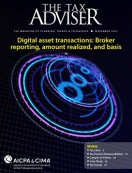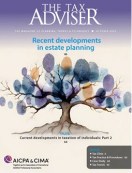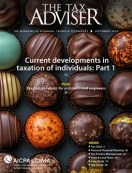- column
- PERSONAL FINANCIAL PLANNING
Planning with charitable remainder trusts
Related
Government withdraws defense of retirement fiduciary rule
IRS outlines details for Trump accounts
How a CPA and wealth adviser partnership can guide families through transition
As taxpayers and advisers have adapted to a higher–interest–rate environment in recent years, it is worthwhile to sharpen planning knowledge of charitable remainder trusts (CRTs). CRTs are an effective way to manage an individual’s personal wealth and philanthropic goals. While charitable lead trusts worked well in a low–interest–rate environment (see Westley and Barral, “Planning With Charitable Lead Trusts,” 52 The Tax Adviser 782 (December 2021)), CRTs generally work best in a high–interest–rate environment.
General overview
CRTs are split–interest trusts that have a noncharitable income beneficiary during the trust’s term and, as the name suggests, a charitable beneficiary entitled to the remainder. CRTs can work best for those with low–basis assets who need an income stream from that asset and have a desire to donate what is left over to charity. While an individual retirement account (IRA) could accomplish a similar gift with a charity listed as the designated beneficiary, the CRT provides an income tax deduction to the donor in the year created for the present value expected to pass to charity. The present–value calculation relies on the IRS’s assumed growth rate, which is the applicable federal rate under Sec. 7520. When the Sec. 7520 rate is high, a smaller value is placed on the amount of the retained interest, producing a larger amount expected to pass to charity and therefore a larger income tax deduction for the donor of a CRT.
There may be added value in CRTs for those looking to divest themselves of certain low–basis investment positions, especially concentrated positions. It is more advantageous to transfer appreciated securities rather than cash to a CRT, due to the income tax deferral available. When appreciated securities are donated to a CRT, they can be sold and reinvested into a more efficient diversified investment portfolio. Moreover, the CRT is invested undiminished by any income taxes, since under Sec. 664(c)(1), the CRT itself is not subject to income tax. However, as discussed below, the distributions to the CRT beneficiary will carry out the capital gains realized within the CRT, providing income tax deferral for the donor.
Under Sec. 664(b), distributions to the beneficiary from the CRT (usually the donor) are categorized by a four–tier accounting system for income tax purposes. These distributions are characterized based on the assets held by the CRT. The distributions are characterized as follows:
- First, ordinary income and such undistributed income of the trust for prior years;
- Second, capital gain (including unrecaptured Sec. 1250 gain and gain on collectibles taxed at 28%) and such undistributed capital gain of the trust for prior years;
- Third, tax-exempt interest and such undistributed income for prior years; and
- Fourth, as a distribution of trust corpus (i.e., return of principal).
The CRT distributions are characterized first by income taxed at the highest income tax rates and progressing to more favorable income tax treatment, earning the term “worst in, first out.”
CRATs
CRTs can generally be broken down into two types: charitable remainder annuity trusts (CRATs) and charitable remainder unitrusts (CRUTs). CRATs require a sum certain that must be no less than 5% and not more than 50% of the initial fair market value (FMV) of the trust. The annuity must be paid at least annually to one or more persons and only to individuals living at the time of the trust’s creation. The trust term may be for the life or lives of such individual beneficiaries or for a term not in excess of 20 years. Using the Sec. 7520 rate, there must be an actuarial basis that at least 10% of the initial net FMV of all property passes to charity. The donor’s desired annuity payment may need to be adjusted to confirm that, prior to funding, there is at least a 10% interest expected to pass to charity. In addition to the “10% rule,” there is also a 5% exhaustion test that applies to CRATs, which is set forth in Rev. Rul. 70–452 and applied in Rev. Rul. 77–374. Rev. Proc. 2016–42 sets forth an alternative remedy to the 5% test with sample CRAT language that essentially terminates the CRAT if the trust decreases to 10% of its initial value. The 5% exhaustion test is more problematic in a low–interest–rate environment.
Example 1. CRAT: D is 60 years old and charitably inclined but is concerned about having enough assets to live on. She creates a CRAT that is funded with $1 million, which will make yearly payments of $50,000 to her, with the remainder passing to charity. The value of the annuity can be determined by using the appropriate Sec. 7520 rate and Table S (2010CM), “One–life factors for annuities,” of IRS Publication 1457, Actuarial Valuations, Version 4A.
Assume that the valuation date occurs during the end of May 2025 when the Sec. 7520 rate is 5%. The flush language of Sec. 7520(a) allows D to elect to use the rate for the preceding two months as well. This allows D to elect to use the April rate of 5% or the March rate of 5.4%. Or she may possibly wait until June, when D may use the revenue ruling posted with the applicable federal rates (AFRs) to see if that rate is possibly higher. This gives D a choice among four rates, and the highest rate should be selected. A higher rate places a smaller value on the retained annuity, thus increasing the amount expected to pass to charity (i.e., increasing the charitable deduction). The Sec. 7520 rate for March 2025 should work best for D. The 5.4% Sec. 7520 rate, Table S, provides an annuity factor of 12.1861 for a 60–year–old donor. The value of the retained annuity is calculated to be $609,305 ($50,000 × 12.1861). This provides a charitable deduction for the donor of $390,695 ($1 million transferred to the CRAT, reduced by the retained annuity of $609,305). Revenue rulings providing the AFRs for the following month are typically published mid–month. June’s Sec. 7520 rate was 5% as well, and had she waited until then, she would only be able to use 5%, which would provide a charitable deduction of only $366,060. As this example demonstrates, CRATs work very well when the AFR is higher.
The fixed–sum payout of CRATs may make them challenging and possibly unpopular for some, because if the investment performance does not keep up with the required annuity payment of at least 5% of the initial FMV ($50,000 annually in the example above), the CRAT risks exhausting its assets prematurely.
CRUTs
Where CRATs require a sum certain for the annuity, CRUTs require a fixed percentage of the net FMV of their assets, valued annually. This fixed percentage will then be distributed to one or more persons who are living at the time of creation of the trust for a term (not to exceed 20 years) or for the life or lives of such individual noncharitable beneficiaries. The fixed percentage may be no less than 5% and not more than 50%. CRUTs also require that in terms of present value, 10% of the property contributed to the trust is expected to pass to charity.
With a fixed percentage being distributed, there is always some percentage remaining in the CRUT, eliminating the risk of early exhaustion that the CRAT contends with. CRUTs also permit additional contributions to the trust, whereas a CRAT cannot make additions (see Regs. Secs. 1.664–2(b) and 1.664–3(b)). The calculation of the charitable deduction for a CRUT is much different, too, because CRUTs are not as materially influenced by the Sec. 7520 rate as compared to CRATs.
Example 2. CRUT: Consider the same facts as above, but instead, a fixed–percentage payout of 5% is made to the 60–year–old over her life. The $1 million transferred to the CRUT is multiplied by the remainder interest found in Table U(1) (2010 CM), “One–life factors for unitrusts,” of IRS Publication 1458, Actuarial Valuations, Version 4B. The remainder interest there is 0.34995 for a 60–year–old with a 5% payout rate. The $1 million transfer to the CRUT can provide a charitable deduction for the donor in the amount of $349,950 ($1,000,000 × 0.34995). Note: The Sec. 7520 rate was not used here in this example, only the adjusted payout rate of 5%, but the Sec. 7520 rate does come into play when factoring in the payout frequency (e.g., monthly, quarterly, etc.) and the difference between the valuation and payment dates. CRUTs are less dependent on the AFR being high to work well for donors.
CRUT variations
NICRUT
CRUTs can be used in their standard form or one of their alternatives. A net–income CRUT (NICRUT) is one alternative to consider. A NICRUT can pay the noncharitable beneficiary the lesser of the unitrust amount (the fixed percentage) or the net income of the trust. This can be particularly useful if the CRUT is not expected to have enough income to pay out the minimum 5% fixed percentage and there is no desire to distribute principal. A NICRUT could make sense if the trust held valuable artwork, undeveloped land, a privately held business, etc. The net income limitation would prevent those assets from having to be sold, perhaps at a fire sale, in order to make any unitrust payment.
NIMCRUT
Another CRUT alternative is the net income with make–up CRUT (NIMCRUT). This type of CRUT is similar to the NICRUT in that it pays out the lesser of the unitrust amount or the net income. However, the NIMCRUT will accrue the unitrust amount that was not distributed into a make–up account, which will be paid out later. In subsequent years when the net income is more than the unitrust amount, that excess will be paid out to the beneficiary. This may be particularly advantageous if the net income of the asset is expected to materialize at some later point, such as retirement, when the beneficiary is expected to be in a more favorable position taxwise (e.g., a lower marginal tax rate).
Flip-CRUT
A flip–CRUT is a NICRUT or NIMCRUT that later “flips” to a standard CRUT upon some triggering event such as the beneficiary’s attaining a certain age (e.g., retirement) or the sale of an asset that was considered hard to sell at the outset of the trust. If the CRUT was a NIMCRUT, then no make–up payments may be made once it flips to a standard CRUT.
QCD election
Division T of the Consolidated Appropriations Act, 2023, P.L. 117–328 (the SECURE 2.0 Act), introduced a one–time election for qualified charitable distributions (QCDs) from IRAs to split–interest entities. Under Sec. 408(d)(8), individuals who have attained the age of 70½ can distribute up to $108,000 annually (as indexed for inflation for 2025) from their IRA directly to a public charity. Section 307 of the SECURE 2.0 Act (Sec. 408(d)(8)(F)) permits a one–time election to distribute up to $50,000 to a split–interest entity ($54,000 for 2025, adjusted for inflation in Notice 2024–80), which includes CRATs, CRUTS, and charitable gift annuities. However, such a trust must be funded exclusively by QCDs, thus creating CRATs and CRUTs limited to the inflation–adjusted amount. For many, the economics of managing a trust of this size may not make sense, although it may be an interesting proposition for charitable gift annuities.
AGI considerations
If the donor’s intention is to maximize and take full use of any charitable deduction available, then planning is required. Transfers to a CRT can create large charitable deductions, and advisers should consider any adjusted–gross–income (AGI) limitations on such deductions, as well as the application of such a contribution in each of the five succeeding tax years. The donor may consider a smaller transfer to the CRT or a higher payout if getting the maximum charitable deduction is desired.
Other considerations
The type of assets held in a CRT is very important. Investments that will generate unrelated business taxable income (UBTI) should be avoided. While the CRT is not subject to federal income tax, it is subject to UBTI (see Sec. 664(c)(2)). The excise tax for UBTI is equal to the entire amount of UBTI, effectively imposing a 100% rate of tax on such income (Sec. 664(c)(2)(A)).
State–level factors must be considered as well for CRUTs that may be paying out net income. Accounting for trust income starts with looking at the governing instrument. However, if the trust agreement is silent, then trust accounting income is determined by state law, which can vary by state. While CRTs are generally not subject to income tax at the federal level, some states, such as New Jersey, impose their gross income tax on CRTs (see N.J. Division of Taxation Technical Bulletin TB–64 (June 29, 2009)).
Estate tax issues for nonspouse succeeding income beneficiary
Upon the death of the donor, the value of the CRT is generally included in the donor’s gross estate. The donor is also entitled to an estate tax charitable deduction for the present value of the charitable remainder interest. In cases where the donor is the only noncharitable beneficiary, the value of the charitable deduction will be the full value of the CRT. However, in the case of a nonspouse successor beneficiary, part of the CRT will not qualify for the estate tax charitable deduction and therefore may generate an estate tax. The CRT itself cannot bear the estate tax burden attributable to its inclusion in the donor’s taxable estate because under Sec. 664(d)(2)(B), no amount other than the unitrust amount may be paid to or for the use of any person other than the charitable remainder (see also Regs. Sec. 1.664–1(a)(6), Example (3)). Therefore, it is important that the donor considers the impact of estate tax inclusion on their overall estate plan and liquidity. The CRT governing document can also mandate that the noncharitable successor beneficiaries pay their share of any estate taxes attributable to their CRT interests as a condition of receiving their unitrusts or annuities.
Fulfilling life goals and reducing taxes
CRTs can work very well for those who are charitably inclined and also looking to defer income tax. Additionally, CRTs can provide great value for assets that are earmarked for charitable giving but pose some concentrated investment risk. Those assets can be transferred to the CRT, where investment risk is immediately reduced by selling the assets and reinvesting the full value of the proceeds in a lower–risk, diversified manner. The donor receives an immediate charitable deduction, avoids the immediate recognition of capital gains tax, and generates an income stream to themselves or another person. Therefore, CRTs can be a powerful way to achieve investment, cash flow, and philanthropic goals while minimizing income, gift, and estate taxes.
Contributors
David M. Barral, CPA/PFS, CFP, is a senior wealth adviser, and Robert A. Westley, CPA/PFS, CFP, is a regional wealth adviser, both with Northern Trust Wealth Management in New York City. For more information about this column, contact thetaxadviser@aicpa.org.














